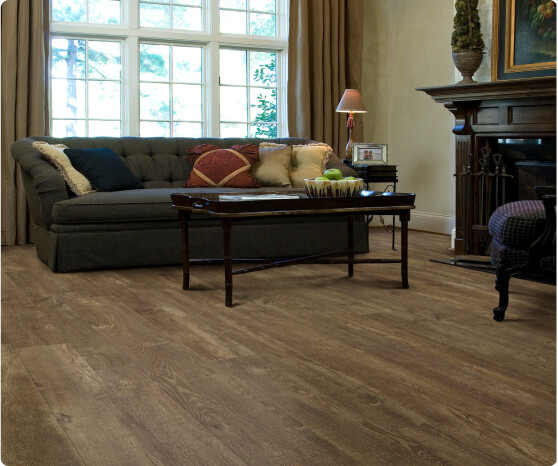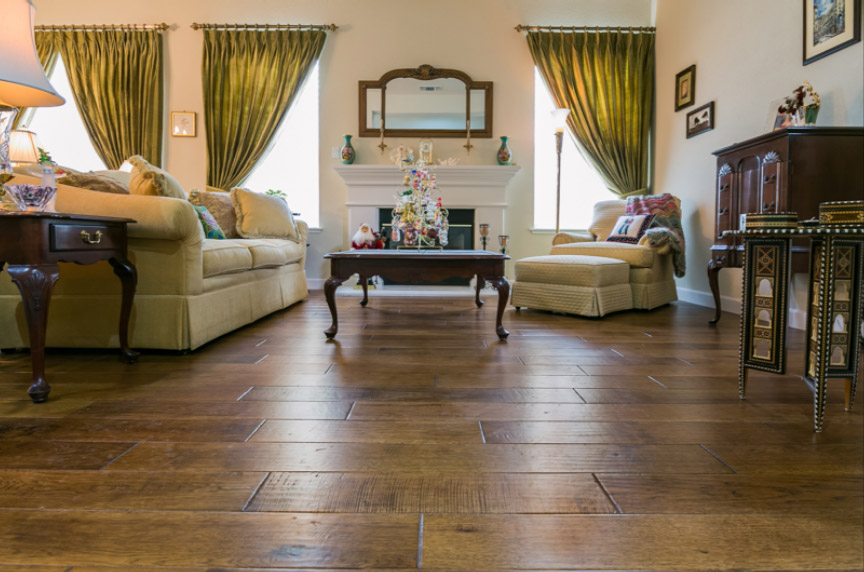Tile flooring is a popular choice among homeowners due to its numerous benefits and aesthetic appeal. Whether you are renovating your existing space or starting a new project, understanding the idea behind tile flooring and its purpose can help you make an informed decision. In this comprehensive guide, we will explore the functionality and placement of tile flooring, as well as the differences in materials and designs available.
One of the key advantages of tile flooring is its durability and versatility. Tiles are known for their ability to withstand heavy foot traffic, making them ideal for high-traffic areas such as kitchens, bathrooms, and entryways. They offer a wide range of design options, allowing you to create a visually stunning room that suits your personal style.
Are you ready to embark on your tile flooring journey? Join us as we dive into the world of tile flooring and provide you with all the information you need to choose the perfect tiles for your home.

Table of Contents
ToggleWhat Is Tile Flooring?
Explore Tile Flooring And Its Characteristics
Tile flooring is a popular choice for many homeowners due to its durability and versatility. It is a type of flooring that uses individual tiles made from various materials, such as ceramic, porcelain, stone, or even metal. These tiles are typically square or rectangular in shape and can be used on both floors and walls.
One of the key characteristics of tile flooring is its durability. Tiles are known for their ability to withstand heavy foot traffic and resist wear and tear over time. They are also resistant to stains, scratches, and moisture, making them an excellent choice for areas with high humidity or spill-prone spaces like kitchens and bathrooms.
Understand Different Materials Used In Tile Flooring
There are several types of materials commonly used in tile flooring:
- Ceramic Tiles: These tiles are made from clay that has been heated at high temperatures. They come in various colors, patterns, and finishes.
- Porcelain Tiles: Porcelain tiles are similar to ceramic tiles but have a lower water absorption rate, making them more suitable for outdoor use.
- Stone Tiles: Natural stone tiles like granite, travertine, or marble offer a unique and elegant look to any space. They are durable but require regular maintenance.
- Metal Tiles: Metallic tiles add a modern touch to any room with their sleek appearance. However, they may require special installation techniques.
Learn About Styles And Designs Available In Tile Flooring
Tile flooring offers a wide range of styles and designs to suit different preferences:
- Patterned Tiles: These tiles feature intricate patterns or designs that can add visual interest to any space.
- Subway Tiles: Subway tiles have become increasingly popular due to their timeless appeal and versatility.
- Mosaic Tiles: Mosaic tiles consist of small pieces arranged together to form a pattern or image.
- Wood-Look Tiles: For those who desire the warmth of wood but prefer the durability of tiles, wood-look tiles mimic the appearance of hardwood flooring.
- Geometric Tiles: Geometric-shaped tiles, such as hexagon or diamond, can create a unique and modern look.
When choosing tile flooring for your home, it is essential to consider factors such as your lifestyle, budget, and the specific area where the tiles will be installed. Proper installation and maintenance are crucial to ensure the longevity and beauty of your tile flooring.
Types Of Tile Flooring
There are several different types to consider. Let’s dive into the various options and their unique features so you can make an informed decision.
Ceramic Tile
Ceramic tile is a popular choice for many homeowners. It is made from clay that has been fired at high temperatures, resulting in a durable and long-lasting material. Here are some key points about ceramic tile:
Pros:
- Available in a wide range of colors, patterns, and styles.
- Easy to clean and maintain.
- Resistant to scratches and stains.
Cons:
- Can be prone to cracking if not properly installed.
- May require regular sealing to prevent water damage.
Porcelain Tile
Porcelain tile is another excellent option for flooring. It is made from a fine mixture of clay and other materials that are kiln-fired at extremely high temperatures. Here’s what you need to know about porcelain tile:
Pros:
- Highly durable and resistant to wear and tear.
- Water-resistant, making it suitable for bathrooms and kitchens.
- Available in various sizes, shapes, colors, and finishes.
Cons:
- More expensive than ceramic tile.
- Can be challenging to install due to its hardness.
Natural Stone Tile
If you’re looking for a more luxurious option, natural stone tile might be the perfect choice. It includes materials like marble, granite, slate, limestone, and travertine. Consider these factors when selecting natural stone tile:
Pros:
- Each type of stone offers a unique appearance with stunning natural patterns.
- Durable and can withstand heavy foot traffic.
- Adds value and elegance to any space.
Cons:
- Requires regular maintenance such as sealing to prevent staining or damage.
- Some types of stone may be more porous than others.
Now that you know about the different types of tile flooring, it’s essential to understand which type is best suited for specific areas in your home. Here are some guidelines to help you make the right choice:
- For high-moisture areas like bathrooms and kitchens, porcelain or ceramic tiles are ideal due to their water resistance.
- Natural stone tiles can add a touch of luxury to living rooms, dining rooms, or entryways.
- Mosaic tiles, which come in various shapes and sizes, can be used creatively as accents or backsplashes.
Remember to consider factors such as durability, maintenance requirements, and aesthetic appeal when selecting tile flooring for each area of your home.
Choosing The Best Floor Tiles For Your Home
It’s important to find ones that match your personal style and preferences. There are a few factors to consider in order to make the right choice. Let’s dive into how you can choose the best floor tiles for your home.
Consider Durability, Maintenance, And Cost
One of the key factors to keep in mind when choosing floor tiles is durability. You want tiles that can withstand daily wear and tear without losing their appeal. For areas with high foot traffic like kitchens or bathrooms, opt for durable options such as porcelain or natural stone like granite or marble.
Maintenance requirements are another crucial aspect to consider. Some tiles may require regular sealing or special cleaning products, while others are more low-maintenance. Luxury vinyl tiles, for example, offer an easy-to-clean surface that is resistant to stains and scratches.
Cost is also an important consideration when choosing floor tiles. Different types of materials come with varying price points. While solid wood may be a top choice for some homeowners due to its timeless appeal, it tends to be more expensive compared to alternatives like porcelain or ceramic tiles.
Striking A Balance Between Functionality And Aesthetics
Finding the perfect balance between functionality and aesthetics is essential when selecting floor tiles. You want your flooring not only to look good but also serve its purpose effectively.
For areas prone to moisture such as bathrooms or basements, consider water-resistant options like porcelain or luxury vinyl tiles. These materials are less likely to warp or get damaged by humidity.
Fireplace surrounds can benefit from heat-resistant materials such as natural stone or porcelain enamel finishes which can withstand high temperatures without cracking or discoloration.
Consider the overall style and theme of your home when choosing floor tiles. Whether you prefer a modern look with sleek ceramic tiles or a rustic feel with natural stone flooring, select options that complement your existing decor.
The Right Choice For Every Room
Different rooms in your home have different requirements. Here are a few suggestions for specific areas:
- Kitchens: Opt for durable, easy-to-clean options like porcelain or ceramic tiles that can handle spills and heavy foot traffic.
- Bathrooms: Choose water-resistant materials such as porcelain or natural stone tiles to prevent moisture damage.
- Basements: Consider luxury vinyl tiles that are resistant to moisture and offer insulation against cold floors.
- Living Areas: Solid wood flooring provides a warm and inviting atmosphere, but if you prefer a more budget-friendly option, laminate or engineered wood can be great alternatives.
Remember, each room has its own unique needs, so take into account factors like foot traffic, moisture levels, and desired aesthetics when selecting floor tiles.
Factors To Consider When Choosing Tile Flooring
There are several important factors you should consider. These factors will help you make an informed decision that not only enhances the aesthetics of your space but also suits your lifestyle and needs.
Room Size, Foot Traffic, And Moisture Levels
The first factor to consider is the size of the room where you plan to install the tile flooring. Larger rooms can accommodate larger tiles, while smaller rooms may benefit from smaller tiles that create an illusion of more space. Think about the amount of foot traffic in the room. If it’s a high-traffic area like a hallway or kitchen, opt for durable tiles that can withstand constant use without showing signs of wear and tear.
Moisture levels are another crucial consideration when selecting tile flooring. Bathrooms, kitchens, and laundry rooms are prone to moisture and require tiles that are water-resistant or have low water absorption rates. Porcelain and ceramic tiles are excellent choices for these areas as they offer exceptional resistance against moisture damage.
Color Scheme And Design Theme
Consider the color scheme and overall design theme of your home when choosing tile flooring. The right color can significantly impact the ambiance of a room. Light-colored tiles can make a small space appear larger and brighter, while darker tones add warmth and coziness to larger areas.
Furthermore, ensure that the chosen tile complements your existing furniture and decor. For instance, if you have vibrant furniture or bold wall colors, neutral-colored tiles can provide balance and prevent overwhelming visual elements in the room.
Different Finishes’ Impact On Appearance And Performance
Tiles come in various finishes such as matte, glossy, textured, or polished. Each finish has its own unique characteristics that affect both appearance and performance.
- Matte Finish: Provides a non-reflective surface with a subtle texture that helps conceal scratches or smudges.
- Glossy Finish: Creates a reflective surface that enhances the brightness of a room but may require more maintenance to keep it looking clean and free from visible marks.
- Textured Finish: Offers slip resistance, making it an ideal choice for areas prone to moisture or where safety is a concern, like bathrooms and entryways.
- Polished Finish: Provides a sleek and sophisticated look but can be slippery when wet, so it may not be suitable for high-moisture areas.
Understanding the impact of different finishes will help you choose tiles that align with your desired aesthetic and functional requirements.
Tips For Selecting The Perfect Floor Tiles For Different Rooms
Choosing the right floor tiles for your home can be a daunting task, especially when you have different rooms with varying requirements. To help you make an informed decision, here are some essential tips to consider when selecting floor tiles for different areas of your house.
Suitable Tiles For High-Moisture Areas
It’s crucial to choose tiles that can withstand water and humidity. Look for tiles that are specifically designed for wet areas and have a low water absorption rate. These types of tiles are usually made from materials such as porcelain or ceramic, which are resistant to moisture.
Slip Resistance Ratings For Safety
In areas prone to spills or water splashes, such as bathrooms or laundry rooms, safety should be a top priority. To ensure slip resistance and prevent accidents, look for floor tiles with a high slip resistance rating. The rating is usually indicated by an “R” value, with higher numbers indicating better slip resistance. Aim for a minimum R9 rating to provide adequate traction in these areas.
Create Illusion Of Spaciousness
If you have smaller rooms in your home that you want to appear more spacious, consider using larger format tiles. These oversized tiles can create an illusion of openness and make the room feel bigger than it actually is. Opting for light-colored tiles can also contribute to this effect by reflecting more light and giving the room an airy feel.
Consider Room Functionality
Each room in your house serves a different purpose, so it’s important to consider functionality when choosing floor tiles. For example:
- In high-traffic areas like the living room or entryway, opt for durable and scratch-resistant tiles.
- For bedrooms or cozy spaces where comfort is key, consider using softer materials like cork or vinyl.
- In laundry rooms or utility spaces where heavy objects may be dropped, choose tiles that are resistant to impact and can withstand heavy loads.
Coordinate With Room Aesthetics
Floor tiles play a significant role in the overall aesthetics of a room. Consider the existing color palette, furniture, and decor when selecting tiles to ensure they complement the room’s style. If you have a specific theme or design scheme in mind, look for tiles that align with your vision. For example, if you prefer a rustic look, consider using natural stone or wood-look tiles.
Remember, choosing floor tiles is not just about appearance; it’s also about practicality and functionality. Take into account factors such as maintenance requirements, durability, and cost when making your decision.
By following these tips and considering the specific needs of each room in your home, you can select the perfect floor tiles that not only enhance the beauty of your space but also meet your practical requirements.
Tile Floor Installation
Proper Subfloor Preparation
Before installing tile floors, it is crucial to understand the importance of proper subfloor preparation. This step ensures that your tile flooring will be durable and long-lasting. One of the key factors in subfloor preparation is ensuring that the surface is clean, level, and free of any debris. This can be achieved by removing any existing flooring materials, such as carpet or vinyl, and thoroughly cleaning the subfloor.
Different Installation Methods
There are various methods to consider based on the type of tiles you have chosen. Two common installation methods are mortar setting and floating systems.
Mortar setting involves applying a layer of thin-set mortar directly to the subfloor before placing each individual tile. This method provides a strong bond between the tile and the subfloor, ensuring stability and durability. It is commonly used for ceramic or porcelain tiles.
On the other hand, floating systems involve using an interlocking mechanism or adhesive tabs to connect each tile together without directly bonding them to the subfloor. This method is often used for vinyl or laminate tiles. Floating systems offer easier installation and can be a great option for DIY enthusiasts.
Necessary Tools And Equipment
Before starting the installation process, make sure you have all necessary tools and equipment ready. Here are some essential items you will need:
- Tile cutter: A tool specifically designed for cutting tiles accurately.
- Trowel: Used to spread adhesive evenly on the subfloor.
- Grout Float: Helps apply grout smoothly into the gaps between tiles.
- Level: Ensures that your tiles are installed evenly without any uneven surfaces.
- Spacers: Used to maintain consistent spacing between tiles during installation.
- Knee Pads: Provide comfort and protect your knees during floor installation.
Having these tools readily available will streamline your installation process and help achieve professional-looking results.
Tile Flooring Care And Maintenance
Essential Tips For Cleaning And Maintaining Your Tile Floors
Taking care of your tile floors is essential to keep them looking their best. Here are some important tips to help you clean and maintain your tile flooring:
- Regular Sweeping: Sweep or vacuum your tile floors regularly to remove loose dirt, dust, and debris. This simple step will prevent scratches and keep your tiles looking clean.
- Mopping With Warm Water: For routine cleaning, mopping with warm water is usually sufficient. Avoid using excessive water as it can seep into the grout lines and cause damage over time.
- Suitable Cleaning Products: It’s crucial to opt for ones that are specifically designed for use on tiles. Look for pH-neutral cleaners that won’t damage the surface or discolor the grout.
- Gentle Scrubbing: For stubborn stains or dirt buildup, a gentle scrubbing may be required. Use a soft-bristle brush or a non-abrasive sponge to scrub the affected area gently. Avoid using harsh chemicals or abrasive scrubbers that can scratch the tiles.
- Grout Cleaning: The grout between the tiles may require special attention as it can easily become discolored over time. You can make a paste of baking soda and water or use a mild bleach solution to clean the grout lines effectively.
Preventing Common Issues With Tile Flooring
To maintain the longevity of your tile floors, it’s important to take preventive measures against common issues such as stains, scratches, and grout discoloration:
- Stain Prevention: Wipe up spills immediately to prevent staining on your tile floor’s surface. Consider using mats or rugs in high-traffic areas like entryways or kitchens to protect against potential stains from shoes or food spills.
- Scratch Protection: Place felt pads under furniture legs to prevent scratches when moving them. Avoid dragging heavy objects across the floor, as this can cause permanent damage to the tiles.
- Grout Sealing: Apply a grout sealer to protect the grout lines from absorbing dirt and liquids. This will help maintain their color and prevent discoloration over time.
- Regular Maintenance: Establish a regular cleaning routine for your tile floors to prevent dirt and grime buildup. By staying consistent with maintenance, you can avoid major cleaning sessions that may require more effort.
Using Unsanded Grout For Tile Flooring
Unsanded grout is a type of grout that is commonly used for tile installations where the grout lines are less than 1/8 inch wide. Here are some benefits of using unsanded grout:
- Smoother Finish: Unsanded grout is finer in texture, which allows for a smoother finish on your tile surfaces.
- Ideal For Delicate Tiles: If you have delicate or easily scratched tiles like marble or glass, unsanded grout is a better choice as it minimizes the risk of scratching during application.
- Better Adhesion: Unsanded grout has better adhesion properties compared to sanded grout, making it suitable for vertical applications such as shower walls or backsplashes.
Remember, always follow the manufacturer’s instructions when using any type of cleaning product or applying unsanded grout to ensure proper usage and optimal results.
Conclusion
In this comprehensive guide, we have explored the different aspects of choosing tile flooring for your home. We started by understanding what tile flooring is and then delved into the various types available in the market. From there, we provided valuable insights on how to choose the best floor tiles for your specific needs, considering factors such as durability, style, and budget.
We shared expert tips on selecting the perfect floor tiles for different rooms in your home, highlighting the importance of considering functionality and aesthetics. We also covered essential information about tile floor installation and provided guidance on proper care and maintenance to ensure longevity.
Now armed with this knowledge, you are ready to make an informed decision. Whether you’re looking for a sleek modern look or a rustic charm, remember to consider factors such as room usage, foot traffic, and personal style preferences. Don’t hesitate to consult with professionals or visit showrooms to see samples firsthand.
Transform your living spaces with beautiful and durable tile flooring today!
Sources:
- /home-improvement/flooring/types-of-flooring/
- /home-improvement/flooring/cheap-flooring-options/
- /home-improvement/flooring/tile-flooring-pros-cons/
- /home-improvement/flooring/how-to-lay-tile-flooring/
- /home-improvement/flooring/radiant-heating-floor-cost/
- /home-improvement/flooring/clean-tile-grout/
Struggling To Find The Perfect Tile Flooring That Aligns With Your Unique Vision?
Nestled in the bustling heart of Concord, California, K Floors is your go-to solution for bringing that vision to life. We’re more than just a flooring company; we’re your partners in creating spaces that exude quality, reliability, and an unmatched selection. Whether you’re envisioning the classic elegance of marble tiles, the rustic charm of ceramic, or the modern appeal of porcelain, our range is as varied as your imagination.
The K Floors difference is unmistakable. Eliminate the guesswork in selecting the ideal tile flooring. Our team of seasoned experts is committed to assisting you at every turn. From complimentary in-home consultations, where we bring our expertise right to your doorstep, to our collaborations with leading vendors, we ensure that excellence isn’t just a claim—it’s our hallmark. Explore our extensive collection, featuring a variety of tile options including Ceramic, Porcelain, Mosaic, and more. Your perfect floor is not just a purchase; it’s a carefully made choice.
At K Floors, we’re dedicated to providing an experience, not just a sale. Based in Concord, California, we’ve skillfully merged traditional craftsmanship with modern styles, ensuring every tile we lay down transforms your space into a place that feels like home. Whether it’s a residential makeover or a commercial revamp, each project we embrace is a reflection of our dedication to quality and authenticity. So why wait? Step into K Floors, and let’s embark on the journey to your ideal tiled floor together.
Disclaimer
The materials available on this website are for informational and entertainment purposes only and not to provide legal advice. You should contact your attorney to obtain advice concerning any particular issue or problem. You should not act or refrain from acting based on any content included in this site without seeking legal or other professional advice. The information presented on this website may not reflect the most current flooring developments. No action should be taken in reliance on the information contained on this website and we disclaim all liability concerning actions taken or not taken based on any or all of the contents of this site to the fullest extent permitted by law.




